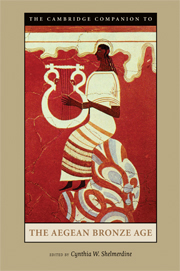Book contents
- Frontmatter
- 1 Background, Sources, and Methods
- 2 The Early Bronze Age in Greece
- 3 The Early Bronze Age in the Cyclades
- 4 Early Prepalatial Crete
- 5 Protopalatial Crete
- 6 The Material Culture of Neopalatial Crete
- 7 Minoan Culture: Religion, Burial Customs, and Administration
- 8 Minoan Crete and the Aegean Islands
- 9 Minoan Trade
- 10 Early Mycenaean Greece
- 11 Mycenaean Art and Architecture
- 12 Mycenaean States
- 13 Burial Customs and Religion
- 14 Mycenaean Greece, the Aegean and Beyond
- 15 Decline, Destruction, Aftermath
- Glossary
- Select Bibliography
- Index
- Plate section
3 - The Early Bronze Age in the Cyclades
Published online by Cambridge University Press: 28 November 2010
- Frontmatter
- 1 Background, Sources, and Methods
- 2 The Early Bronze Age in Greece
- 3 The Early Bronze Age in the Cyclades
- 4 Early Prepalatial Crete
- 5 Protopalatial Crete
- 6 The Material Culture of Neopalatial Crete
- 7 Minoan Culture: Religion, Burial Customs, and Administration
- 8 Minoan Crete and the Aegean Islands
- 9 Minoan Trade
- 10 Early Mycenaean Greece
- 11 Mycenaean Art and Architecture
- 12 Mycenaean States
- 13 Burial Customs and Religion
- 14 Mycenaean Greece, the Aegean and Beyond
- 15 Decline, Destruction, Aftermath
- Glossary
- Select Bibliography
- Index
- Plate section
Summary
The Significance of Early Cycladic Prehistory
The Early Bronze Age of the Cycladic islands occupies a remarkable place in Aegean prehistory, out of all proportion to the modest numbers of people who inhabited them. Why have these 30-odd islands enjoyed so much attention? Their average size is a mere 75 sq. km., many are far smaller, and the largest island, Naxos, is hardly a giant in Aegean terms. Even if all the Cyclades are added together, the resultant ca. 2,580 sq. km. is a fraction of Crete or the Peloponnese. Nor, under Early Bronze Age conditions, did these islands offer obviously inviting opportunities for settlement. Despite their popularity today as a tourist paradise, the rugged masses of rock that make up the Cyclades are (save in a few fertile valleys and coastal plains) thinly covered with soil and short of water; they occupy the poorest end of the spectrum of viable environments for farming communities. These features were crucial in shaping the small-scale societies that inhabited these islands in the Early Bronze Age, but can hardly explain the prominence of early Cycladic prehistory in archaeological literature and the popular imagination.
To understand this significance, we need to look elsewhere. One obvious factor is that the Cyclades lie at the heart of the southern Aegean. The northernmost islands brush the coasts of Attica and Euboea, the eastern islands glance back to the southeast Aegean and Anatolia, the dark volcano of Thera (also known as Santorini) stands sentinel over the open sea toward Crete and, to the west, Melos lies midway between Crete and the Peloponnese.
- Type
- Chapter
- Information
- The Cambridge Companion to the Aegean Bronze Age , pp. 47 - 76Publisher: Cambridge University PressPrint publication year: 2008
- 10
- Cited by

